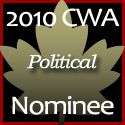 Embassy Magazine has an interesting piece this week on the procurement of the F-35's and Harper's veil of secrecy surrounding it.
Embassy Magazine has an interesting piece this week on the procurement of the F-35's and Harper's veil of secrecy surrounding it.The author of the story, Carl Meyer, asks: Has F-35 procurement process been ‘twisted’?
The Department of National Defence says it is hiding a key F-35 document from the public because that type of document is classified. Yet its own website hosts many of these same types of papers for public downloading, almost all of which are marked as "unclassified." This has prompted allegations the Harper government and military have "twisted" Canada’s procurement process so it can buy the billion-dollar planes.This type of document is called a "Statement of Operational Requirements," and is typically released publicly so Canadians can examine what their armed forces need before their tax dollars are spent. But we have not been given that opportunity, and the few accountings they do give us, have been disputed by experts, including our own Parliamentary budget officer.
However in an unusual step, the Harper government did not release an operational requirements statement before announcing its plan to replace Canada’s fleet of ageing CF-18 fighter jets with the F-35. In fact, the military has admitted it chose the F-35 before it even drew up the Statement of Operational Requirements.Instead of giving us the required documents, they have released a two-page memo, nothing close to the original, which would have been as many as 100.
But considering that we now know that the military was kicking the tires of F-35s as far back as 2006, there may be another reason for not making the details of the procurement public. The planes had a lot of design problems.
On May 3, 2007, during the 19th test flight of the prototype of the F-35A Joint Strike Fighter (JSF), a serious electrical malfunction occurred in the control of the plane. After an emergency landing the malfunction could be identified as a crucial problem, and it became clear that redesign of critical electronic components was necessary. Producer Lockheed Martin and program officials first announced there was a minor problem, and later on they avoided any further publicity about the problems.But not reporting on their problems did not mean that they had been solved. In fact, even now many military experts are claiming that the F-35s will be a maintenance nightmare, and while Canadians can bid on maintenance contracts, there is absolutely no guarantee that any of our firms will be able to cash in. Since taxpayers will be on the hoof for the enormous costs, it would be at least nice to know that there could be good jobs created. But so far rumours indicate that Israel may have already been promised much of the gravy. What gravy the U.S. didn't need for themselves.
Fine.
But let's look at the Harper government's justifications for these planes. Protection of the Arctic appears to be their biggest boast, but these planes have since been determined not to be suitable for Arctic operations. No doubt another reason why Harper has buried the report.
The plane's stealth and ground-attack capabilities make it ill-suited for patrolling the arctic. The F-35 is made for "shock and awe" bombing missions abroad, but Canada has only dropped bombs from its aircraft once since the Second World War (in Kosovo). And the air force never sent its current fleet of CF-18 fighter-bombers to Afghanistan during a decade of war.The F-35's, the Must Have Toy of the Season
Another recent article about the F-35s is worth reading. Barry Neild with the Global Post is asking Why is Obama peddling Lockheed Martin’s stealth F-35 fighter around the world? Especially important since their defense minister wants to reduce his own country's purchase of the plane by half, and they have cancelled plans for replacement engines.
So why has the American president become a travelling salesman for Lockheed Martin, and is it wise to sell this type of aircraft to just anyone?
To some, it might seem odd that the commander-in-chief is willing to hand over keys to aircraft packed to the hilt with the latest U.S. military technology — particularly radar-evading stealth, which no other country yet has — even if the paying customers are allies. At a time of global instability, particularly in the Middle East, some observers say this hard sell is risky. In the 1970s, the United States sold F-14 fighters to a friendly, seemingly-stable Iran. These later fell into hostile hands after a regime change.Neild suggests that the main reason for the sales pitch is to aid in economic recovery.
“It’s big business, and it’s long term business. You don't sell an aircraft and that's the end of the company's involvement — it goes on for at least 30 years.” Jeff Abramson, deputy director of the Arms Control Association, argues that attempts to sell the F-35 overseas are part of the Obama administration’s efforts to double U.S. arms exports and thus aid economic recovery.If the planes are being pushed to aid U.S. recovery, are there not better ways to stimulate the economy than getting involved in an arms race? Any suggested advantage that Canada will have with these planes is just smoke, because everyone, friends or foe, will be sporting these news babies. They are just for show.
But even if F-35s are merely being deployed against economic uncertainty rather than into aerial combat, Abramson warned of other consequences. “In general, it is unwise to think of arms sales as just any other commercial transaction,” he said, suggesting that the F-35s could be vulnerable to misuse or even contribute to regional arms races and instability. “Any transfer agreement must consider whether the proposed weapons are appropriate for their intended use, and whether they might contribute to regional arms races or instability. It’s not clear that all the discussions around F-35s have adequately taken these considerations in mind.”
Steven Staples, President of the Rideau Institute, reminds us that former President Eisenhower warned us of defense spending becoming an economic tool.
Eisenhower, a war hero and former five-star general, was not a pacifist. Instead he called for "balance between our essential requirements as a nation and the duties imposed by the nation upon the individual." Many in Canada support having a military for natural disasters, search and rescue, protecting our sovereignty, and UN peacekeeping. But this is contingent upon a reasonable cost to the taxpayer, and must be considered alongside other priorities such as healthcare.Money put into healtcare, the environment, and the eradication of poverty, will also create jobs. Ethical jobs. These planes are just for show, but in the end, will impress no one. They are so last week. Like showing up a party and everyone is wearing your dress.
In an earlier speech, Eisenhower put the choice starkly: "Every gun that is made, every warship launched, every rocket fired signifies, in the final sense, a theft from those who hunger and are not fed, those who are cold and not clothed."



Yeah. A one-engine jet to patrol the Arctic. Nice at minus 30 Celsius when you have to scramble. Nice also when you ditch and the next town is 300 miles away. Could turn into a Dieppe-like or widowmaker mess in no time flat.
ReplyDelete